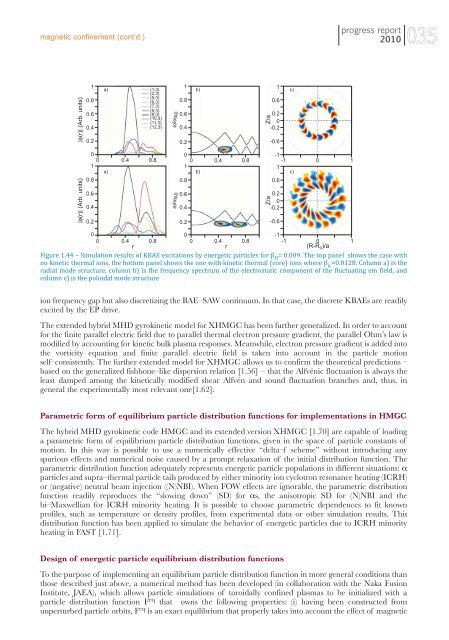Prime pagine RA2010FUS:Copia di Layout 1 - ENEA - Fusione
Prime pagine RA2010FUS:Copia di Layout 1 - ENEA - Fusione
Prime pagine RA2010FUS:Copia di Layout 1 - ENEA - Fusione
You also want an ePaper? Increase the reach of your titles
YUMPU automatically turns print PDFs into web optimized ePapers that Google loves.
magnetic confinement (cont’d.)<br />
progress report<br />
2010<br />
035<br />
|φ(r)| (Arb. units) |φ(r)| (Arb. units)<br />
1<br />
0.8<br />
0.6<br />
0.4<br />
0.2<br />
0<br />
0<br />
1<br />
0.8<br />
0.6<br />
0.4<br />
0.2<br />
a)<br />
1<br />
(1,3)<br />
b)<br />
1<br />
(2,3)<br />
c)<br />
(5,3)<br />
(6,3)<br />
(7,3)<br />
0.8<br />
0.6<br />
(8,3)<br />
(9,3) 0.6<br />
0.2<br />
(10,3)<br />
(11,3)<br />
0<br />
(12,3) 0.4<br />
-0.2<br />
ω/ω A0 ω/ω A0<br />
0.2<br />
0<br />
-1<br />
0.4 0.8<br />
0 0.4 0.8<br />
-1<br />
1<br />
1<br />
a) b) c)<br />
0.8<br />
0.6<br />
0.4<br />
0.2<br />
Z/a Z/a<br />
-0.6<br />
0.6<br />
0.2<br />
0<br />
-0.2<br />
-0.6<br />
0 1<br />
0<br />
0<br />
-1<br />
0 0.4 0.8<br />
0 0.4 0.8<br />
-1<br />
0 1<br />
r<br />
r<br />
(R-R 0 )/a<br />
Figure 1.44 – Simulation results of KBAE excitations by energetic particles for β H = 0.009. The top panel shows the case with<br />
no kinetic thermal ions, the bottom panel shows the one with kinetic thermal (core) ions where β ic =0.0128. Column a) is the<br />
ra<strong>di</strong>al mode structure, column b) is the frequency spectrum of the electrostatic component of the fluctuating em field, and<br />
column c) is the poloidal mode structure<br />
ion frequency gap but also <strong>di</strong>scretizing the BAE–SAW continuum. In that case, the <strong>di</strong>screte KBAEs are rea<strong>di</strong>ly<br />
excited by the EP drive.<br />
The extended hybrid MHD gyrokinetic model for XHMGC has been further generalized. In order to account<br />
for the finite parallel electric field due to parallel thermal electron pressure gra<strong>di</strong>ent, the parallel Ohm’s law is<br />
mo<strong>di</strong>fied by accounting for kinetic bulk plasma responses. Meanwhile, electron pressure gra<strong>di</strong>ent is added into<br />
the vorticity equation and finite parallel electric field is taken into account in the particle motion<br />
self–consistently. The further extended model for XHMGC allows us to confirm the theoretical pre<strong>di</strong>ctions –<br />
based on the generalized fishbone–like <strong>di</strong>spersion relation [1.56] – that the Alfvénic fluctuation is always the<br />
least damped among the kinetically mo<strong>di</strong>fied shear Alfvén and sound fluctuation branches and, thus, in<br />
general the experimentally most relevant one[1.62].<br />
Parametric form of equilibrium particle <strong>di</strong>stribution functions for implementations in HMGC<br />
The hybrid MHD gyrokinetic code HMGC and its extended version XHMGC [1.70] are capable of loa<strong>di</strong>ng<br />
a parametric form of equilibrium particle <strong>di</strong>stribution functions, given in the space of particle constants of<br />
motion. In this way is possible to use a numerically effective “delta–f scheme” without introducing any<br />
spurious effects and numerical noise caused by a prompt relaxation of the initial <strong>di</strong>stribution function. The<br />
parametric <strong>di</strong>stribution function adequately represents energetic particle populations in <strong>di</strong>fferent situations: α<br />
particles and supra–thermal particle tails produced by either minority ion cyclotron resonance heating (ICRH)<br />
or (negative) neutral beam injection ((N)NBI). When FOW effects are ignorable, the parametric <strong>di</strong>stribution<br />
function rea<strong>di</strong>ly reproduces the “slowing down” (SD) for αs, the anisotropic SD for (N)NBI and the<br />
bi–Maxwellian for ICRH minority heating. It is possible to choose parametric dependences to fit known<br />
profiles, such as temperature or density profiles, from experimental data or other simulation results. This<br />
<strong>di</strong>stribution function has been applied to simulate the behavior of energetic particles due to ICRH minority<br />
heating in FAST [1.71].<br />
Design of energetic particle equilibrium <strong>di</strong>stribution functions<br />
To the purpose of implementing an equilibrium particle <strong>di</strong>stribution function in more general con<strong>di</strong>tions than<br />
those described just above, a numerical method has been developed (in collaboration with the Naka Fusion<br />
Institute, JAEA), which allows particle simulations of toroidally confined plasmas to be initialized with a<br />
particle <strong>di</strong>stribution function F eq that owns the following properties: (i) having been constructed from<br />
unperturbed particle orbits, F eq is an exact equilibrium that properly takes into account the effect of magnetic













